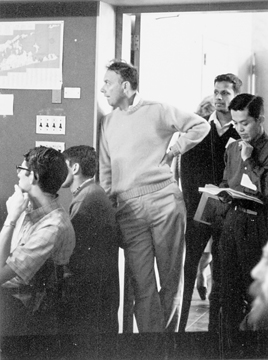1968: Replication of DNA in Microorganisms, Vol. XXXIII
Organizer: John Cairns
n his foreword to the 1968 Symposium volume, John Cairns describes a state of affairs ("...the exact mechanism of DNA duplication has become more rather than less obscure with the passage of time") similar to that lamented by Demerec in 1951 ("...the large body of information accumulated since 1941 has made geneticists less certain than ever about the physical properties of genes"). Nevertheless, Symposium XXXIII highlighted progress in many areas and Hotchkiss was able, in his summary of the meeting, to talk of how the new experimental results were forcing a new view of the DNA molecule: "...it has become necessary to face the fact that DNA grows, issues directives, opens up, closes, twists, and untwists. We are coming to realize how marvelously communicative it is, and that it is not an aloof, metabolically inert material..."
One major difficulty was how DNA polymerase(s), known to synthesize DNA exclusively in the 5' to 3' direction, could replicate the antiparallel strands of the double helix in the same overall direction. Reiji Okazaki presented models for a discontinuous mechanism of DNA replication and made two predictions based on the models: the existence of short chains corresponding to recently synthesized DNA, and the accumulation of such chains in a thermosensitive DNA ligase mutant shifted to high temperature. Okazaki's data supported both predictions. As Rollin Hotchkiss put it in his summary of the meeting, "Okazaki was able to sit back and allow others to toss flowers into his lap through the succeeding days, for there were several confirmations [of his ideas]." (Hotchkiss's wonderful Symposium summary is filled with lively and entertaining prose.) Interestingly, a second major problem that had preoccupied Delbruck and others-how the double helix unwound-had,
| 
apparently, faded from view and was discussed in depth only in Peter Davison's paper.
Other talks focused on the nature of origins of replication, bidirectional DNA replication and the rolling circle model of DNA replication. An important feature of the meeting was the comprehensive coverage of DNA repair, contrasting the distinct enzymology of replicative versus repair DNA synthesis. And while the session on the replication of viruses was concerned almost exclusively with phage DNA, Renato Dulbecco described his research on what happened to the DNA genomes of polyoma and SV40 tumor viruses after they have infected a cell. He showed that the viral DNAs were integrated into the host cell genome.
This work forshadowed research that was to become central to the efforts of Cold Spring Harbor Laboratory through the 1970s and 1980s. John Cairns stepped down from the directorship in 1968 and James Watson took over, initially dividing his time between Cold Spring Harbor and Harvard. Watson's goal was to use DNA tumor viruses to dissect out the genetic basis of cancer, and one of his first appointments was Joe Sambrook who came from Dulbecco's laboratory.
— Peter Sherwood |